Dip packaging (Dual In-line Package), also known as dual-line in-line packaging technology, refers to the integrated circuit chips that are packaged in the form of dual-line in-line in DIP processing in PCBA manufacturer of PCB board. Now most small and medium-scale integrated circuits use this kind of packaging method, and the pin number generally does not exceed 100; The DIP-packed CPU chip has two pins, which need to be inserted into the chip socket with dip structure or directly into the PCB board printed circuit board with the same number of weld holes and geometric arrangement for welding.
DIP-encapsulated chips must be carefully inserted from the chip socket to avoid damaging the pins when handled by SMT technicians. The DIP packaging structure forms are: multi-layer ceramics double-line in-line DIP, single-layer ceramics double-line in-line DIP, lead frame DIP (including glass-ceramic sealing, plastic-encapsulated structure, ceramic low-melt glass packaging), etc.

DIP plug-in patch post-processing welding is a process after SMT patch processing (except for special cases: only the PCB board of the plug-in), the processing flow is as follows:
1. Pre-processing of components
The worker in the pre-processing shop will pick up the materials in the BOM according to the BOM bill of materials, carefully check the type and specifications of the materials, sign them, pre-process according to the template before production, and process them with the moulding equipment such as automatic bulk capacitor foot shearing machine, transistor automatic moulding machine and automatic belt moulding machine.
Requirement:
(1) The pin horizontal width of the adjusted component must be the same as that of the positioning hole, with a tolerance of less than 5%;
(2) The distance from the pin of the component to the bonding pad of the PCB circuit board should not be too large;
(3) If the customer requests, the parts need to be moulded to provide mechanical support to prevent the pad of the PCB circuit board from warping up.
2. Stick high-temperature adhesive paper, enter PCB board Stick high-temperature adhesive paper, block tin-plated through holes and components that must be soldered back;
3. DIP plug-in processing workers must wear electrostatic hand rings to prevent static electricity from occurring. Plug-in processing should be carried out according to BOM list of components and bitmap of components. Smt patch processing operators must be careful when plugging-in, and no errors or leakage can occur.
4. For the components that have been inserted, the operator must check them, mainly whether they are inserted incorrectly or not.
5. For PCB boards with no problems in plug-in, the next step is wave soldering, which can be used to weld all-round automatic PCB boards and solidify components.
6. Remove the high temperature adhesive paper, and then check it. In this link, the main step is visual inspection to see if the welded PCB board is well welded by naked eye.
7. For PCB boards that have been checked out to be not welded completely, repairs should be made to prevent problems.
8. Post-weld, which is a set procedure for components with special requirements, because some components cannot be directly welded by peak welder according to their own process and material limitations, so it needs to be done manually by operators.
9. For all components on the PCB circuit board bonding pad, the PCB board will also need to be processed for functional testing after the PCB circuit board bonding is completed, to test whether each function is in normal state, if defective function is detected. The worker needs to do the identification of the pending process immediately before repairing and re-testing the PCB circuit board.